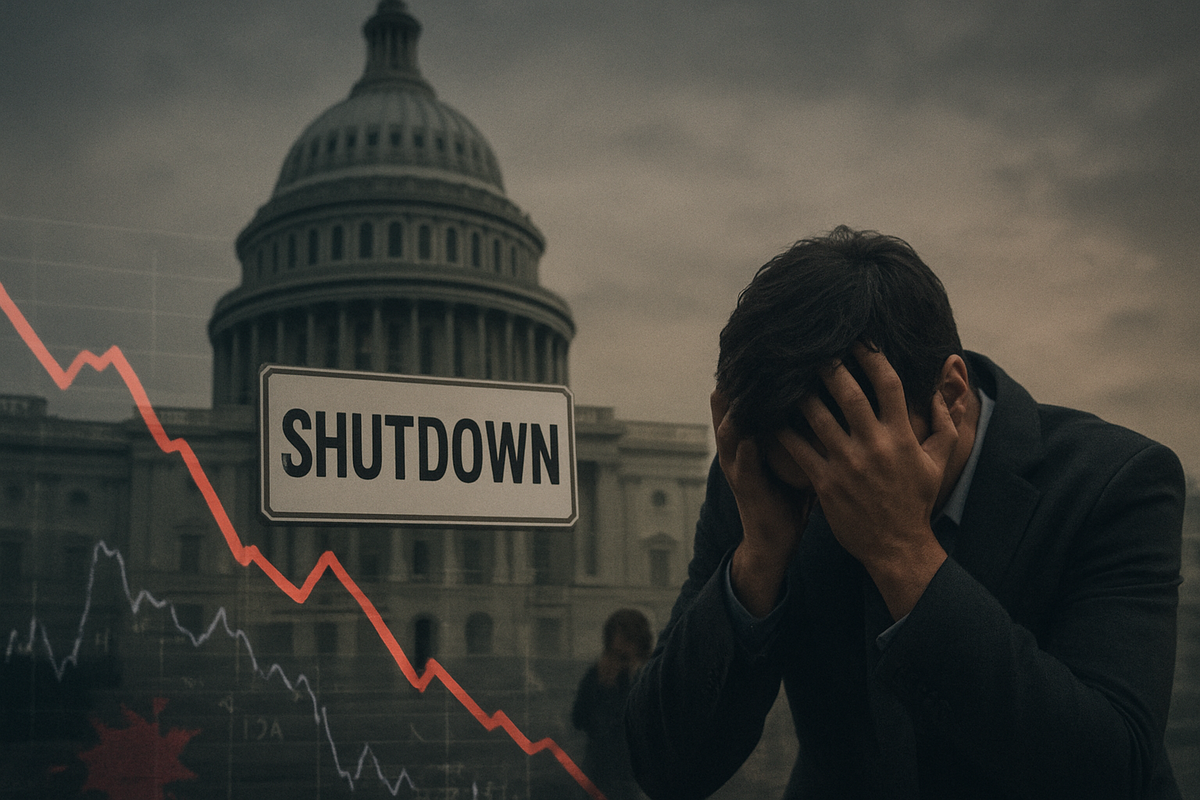
Washington D.C., November 5, 2025 – The United States is grappling with an unprecedented fiscal crisis, as an ongoing government shutdown, now in its 36th day, has officially become the longest in the nation's history. This prolonged political impasse, rooted in fierce partisan disagreements over federal spending and policy riders, has cast a long shadow over financial markets, disrupting critical services, delaying vital economic data, and fostering a pervasive sense of uncertainty across the economy. While historical precedents suggest market resilience, the sheer duration of this shutdown, coupled with recent inflammatory comments from former President Donald Trump and the disruption to key economic indicators like the ADP report, signals a potentially more profound and lasting impact on the market and public companies.
Shutdown's Genesis and Market's Uneasy Calm
The current government shutdown began on October 1, 2025, the start of the federal fiscal year, after Congress failed to pass the necessary 12 annual appropriations bills or even a temporary continuing resolution (CR) to fund federal operations. The core of the disagreement reportedly centers on the Democratic Party's push to extend Affordable Care Act (ACA) premium tax credits, which are set to expire, and the Republican Party's staunch opposition, demanding significant spending cuts and other policy concessions.
As the days turned into weeks, non-essential government services ground to a halt. Hundreds of thousands of federal employees were furloughed without pay, while an equal number of essential personnel, including air traffic controllers and border security agents, were forced to work without immediate compensation. This disruption has rippled through various sectors, from the closure of national parks and museums to delays in critical regulatory approvals.
Former President Donald Trump, a prominent voice in the Republican party, has injected further volatility into the political discourse. In recent comments made around November 2, 2025, Trump reportedly stated he "won't be extorted" by Democrats demanding ACA subsidy extensions, insisting he would only negotiate once the government is reopened. He has criticized Democrats for "losing their way" and predicted their "capitulation," while also pressuring Republican senators to abolish the filibuster rule to push through their legislative agenda. Following recent off-year election losses, Trump attributed the results, in part, to the ongoing shutdown, acknowledging its unpopularity.
The financial markets have reacted with a mix of unease and a surprising degree of resilience. Initially, the shutdown triggered a "risk-off" sentiment, leading to increased market volatility, reflected in a rise in the CBOE Volatility Index (VIX). Investors moved towards safe-haven assets, with U.S. Treasury bonds seeing increased demand and gold prices embarking on a record-breaking rally. However, despite the political gridlock and the historic length of the shutdown, the S&P 500 (SPX) has reportedly reached fresh record highs, although some analysts observe underlying signs of market tension, such as tight trading ranges and hypersensitivity to news flow. This apparent market resilience, while notable, masks significant underlying concerns, particularly regarding the disruption of economic data.
A critical consequence of the shutdown has been the halting of official economic data releases from federal agencies. Key reports from the Bureau of Labor Statistics (BLS) and the Census Bureau, including crucial employment and inflation figures, have been delayed or suspended. This "data blackout" creates an information vacuum, making it challenging for investors, economists, and the Federal Reserve to accurately assess the economy's health and make informed decisions, especially concerning monetary policy and interest rates. In the absence of official figures, private sector reports, such as the ADP National Employment Report, have gained heightened attention. For October 2025, the ADP report, released around November 5, indicated a modest increase of 28,000 to 42,000 private sector jobs, partially reversing a previous decline. However, economists caution that ADP data, while valuable, can diverge from the more comprehensive official BLS figures, potentially leading to market volatility once the official data is eventually released.
Corporate Fortunes: Who Wins and Who Loses Amidst the Fiscal Freeze
The prolonged government shutdown is creating a distinct bifurcation in corporate fortunes, with some sectors and companies facing severe headwinds while others, though few, might prove more resilient or even find niche opportunities. Economists estimate that each week of a shutdown can reduce annualized GDP growth by approximately 0.1% to 0.15%, with the current shutdown projected to reduce fourth-quarter 2025 growth by 1% to 2%, leading to a permanent loss of $7 billion to $14 billion in real GDP.
Companies and Sectors on the Losing End:
- Government Contractors and Professional Services: This sector faces immediate and severe consequences. Many federal agencies issue stop-work orders, halting ongoing projects and preventing new contracts. Payments for services rendered are delayed, creating significant cash flow disruptions. Unlike federal employees, contractors are generally not guaranteed back pay, resulting in lost revenue. Small and mid-sized contractors are particularly vulnerable. Firms like Booz Allen Hamilton (NYSE: BAH), Leidos (NYSE: LDOS), and CACI International (NYSE: CACI), heavily reliant on federal contracts, could experience delays in revenue recognition and new project starts.
- Defense Industry: While some essential defense activities continue, the shutdown significantly delays new contract awards and slows down the Pentagon's decision-making. Major defense primes such as Lockheed Martin (NYSE: LMT), Raytheon Technologies (NYSE: RTX), Northrop Grumman (NYSE: NOC), and L3Harris Technologies (NYSE: LHX) could see delays in significant program milestones and new orders. Smaller, innovative defense technology companies might face severe funding gaps.
- Healthcare Sector: The shutdown causes operational and financial problems. While Medicare and Medicaid claims generally continue, critical functions like provider oversight, grant distribution, and regulatory approvals for drugs and medical devices by the Food and Drug Administration (FDA) are delayed or suspended, postponing the availability of new therapies. Pharmaceutical companies like Pfizer (NYSE: PFE) and Johnson & Johnson (NYSE: JNJ) awaiting FDA approvals could see significant delays. Federally Qualified Health Centers (FQHCs) and various social determinant of health programs also face funding disruptions.
- Travel and Tourism: The shutdown directly impacts federal agencies critical to travel, such as the Transportation Security Administration (TSA) and the Federal Aviation Administration (FAA). Widespread absences among unpaid air traffic controllers and TSA officers can lead to longer airport security lines, flight delays, and cancellations. National parks and federally managed attractions are closed, deterring tourism. Airlines like United Airlines (NASDAQ: UAL), Delta Air Lines (NYSE: DAL), and American Airlines (NASDAQ: AAL), along with hotel chains such as Hilton (NYSE: HLT) and Marriott International (NASDAQ: MAR), are directly impacted. United Airlines CEO Scott Kirby has already warned of impacts on flight bookings.
- Retail and Consumer Discretionary: The furloughing of federal employees and essential workers working without pay leads to reduced consumer spending, particularly in areas with large federal workforces. Delays in Supplemental Nutrition Assistance Program (SNAP) benefits further reduce spending at grocery stores and other retailers.
- Financial Services and Regulated Industries: Regulatory agencies like the SEC and CFTC operate with reduced staff, suspending most regulatory activities, including registration reviews and examinations. This creates uncertainty and delays for firms requiring new registrations or approvals.
Sectors and Companies That Might Be Less Affected (or find niche opportunities):
- Companies with Fully Funded or "Excepted" Government Contracts: Some government operations deemed essential for national security or public safety continue. Contractors supporting these activities, or those funded by prior-year appropriations, may see continued payments.
- Companies Providing Emergency/Contingency Services: Businesses offering short-term bridge financing or credit solutions to small businesses and individuals affected by delayed federal payments could see increased demand.
- E-commerce and Discount Retailers (in specific scenarios): As consumers tighten their belts and reduce travel, online retailers like Amazon (NASDAQ: AMZN) or discount stores such as Walmart (NYSE: WMT) and Dollar General (NYSE: DG) might capture a larger share of the reduced consumer spending, benefiting from a shift towards more frugal options.
- Companies Operating Primarily Outside Federal Influence: Businesses with minimal direct or indirect ties to federal contracts, regulations, or federal employee consumer bases, particularly those focused on state/local government contracts or private sector demand, might be less affected.
Wider Significance: A Deep Dive into Systemic Impacts
The current, historically long U.S. government shutdown in November 2025 is more than a temporary blip; it's a stark indicator of entrenched political polarization and a catalyst for broader systemic impacts across the economy and global standing. This event fits into a disturbing trend of increasingly frequent and impactful funding impasses, signaling deeper vulnerabilities.
Each week of the shutdown contributes to a tangible reduction in annualized GDP growth, with the Congressional Budget Office (CBO) estimating a potential 1% to 2% reduction in fourth-quarter 2025 growth and a permanent loss of $7 billion to $14 billion in real GDP. Beyond the immediate economic hit, the shutdown erodes consumer and business confidence, impacting investment and hiring decisions, particularly for lower-income households reliant on immediate government assistance. While the S&P 500 has historically shown resilience to short shutdowns, the current prolonged nature risks a more significant and lasting psychological blow to market sentiment, potentially amplifying volatility and driving investors further into safe-haven assets like U.S. Treasury bonds and gold.
The ripple effects extend far beyond federal employees and direct contractors. Supply chains are strained by disruptions in customs processing, trade negotiations, and regulatory approvals. Air travel faces significant challenges as unpaid air traffic controllers and TSA employees lead to staff shortages, longer lines, flight delays, and even warnings of potential airspace closures. Trucking also faces bottlenecks due to paused permitting and background checks. At ports, slowdowns due to reduced Customs and Border Protection staff can lead to longer wait times and higher costs.
Healthcare and social services are severely impacted. Enhanced subsidies for the Affordable Care Act (ACA) marketplace are set to expire, potentially doubling or tripling health insurance premiums for millions. Medical research, especially at the National Institutes of Health (NIH), is paused, and critical programs like the Supplemental Nutrition Assistance Program (SNAP) face funding issues, threatening food assistance for 42 million people.
Internationally, the political gridlock signals instability, potentially weakening the U.S. dollar, spooking global markets, and deterring international investors. Delays in processing export licenses from agencies like the Bureau of Industry and Security (BIS) and the Directorate of Defense Trade Controls (DDTC) directly impact U.S. businesses involved in global trade and their foreign partners.
From a regulatory standpoint, the shutdown severely hampers government functions. Non-essential regulatory activities, including registration reviews, examinations, and rulemaking processes, are suspended at key agencies like the Securities and Exchange Commission (SEC) and the Commodity Futures Trading Commission (CFTC). This creates uncertainty and delays for regulated firms. The "data blackout" from federal statistical agencies further complicates decision-making for businesses, investors, and even the Federal Reserve, potentially impacting monetary policy decisions regarding interest rates. Furthermore, the expiration of provisions of the Defense Production Act, essential for national defense industrial base support, impacts new contracts and investments. The current shutdown, reportedly driven by disputes over healthcare concessions and broader spending disagreements, underscores an entrenched political polarization that makes legislative compromise increasingly difficult, raising questions about the long-term governance capacity of the nation.
Historically, this 36-day shutdown has now surpassed the previous record of 35 days set during the Trump administration from December 2018 to January 2019. Other significant shutdowns include the 21-day event in 1995-1996 and the 16-day shutdown in 2013. The recurring nature of these impasses, particularly since 1990, indicates a shift where shutdowns have become a more frequent political tool for leverage in budgetary and policy disputes. While a 2019 law guarantees retroactive pay for furloughed federal employees, federal contractors do not have the same assurance, creating a two-tiered impact. The current record-breaking duration amplifies these historical consequences, suggesting that the economic and social costs are mounting to unprecedented levels.
What Comes Next: Navigating the Path Forward
The path forward from the ongoing U.S. government shutdown in November 2025 is fraught with both short-term challenges and long-term uncertainties, demanding strategic pivots from investors and businesses alike. The duration and eventual resolution of this historic shutdown will dictate the immediate and lasting impacts on the market and the broader economy.
In the short term, the most immediate consequence is a continued economic slowdown. The CBO's estimates of a 1% to 2% reduction in Q4 2025 GDP growth highlight the direct federal spending cessation, income disruption for hundreds of thousands of federal employees, and suspended contractor payments. Market volatility is likely to persist, with day-to-day swings influenced by political headlines and negotiation updates. The "information drought" caused by delayed economic data will continue to complicate decision-making for investors and the Federal Reserve, potentially leading to policy missteps if crucial data is unavailable for too long. Sectors heavily dependent on government contracts, such as defense and certain IT providers, will continue to face delayed payments and revenue gaps, potentially leading to further stock price dislocations. Currency and bond markets will also remain under pressure, with potential for continued demand for U.S. Treasuries as a safe haven, but also risks of U.S. dollar devaluation due to perceived instability.
Looking further ahead into 2026 and beyond, the long-term possibilities hinge on the shutdown's resolution. Historically, much of the economic activity lost during a shutdown is recouped once government operations resume, suggesting a potential rebound in Q1 2026. The stock market has also demonstrated resilience, with the S&P 500 often posting solid gains in the 12 months following past shutdowns. However, the unprecedented length of this shutdown introduces a higher risk of permanent economic damage, as estimated by the CBO. A prolonged or repeated shutdown could erode consumer and business confidence, affecting investment and hiring decisions, and potentially leading to a higher jobless rate and slower wage growth over time. Furthermore, the risk of credit rating agencies issuing further downgrades on federal government debt, as Moody's did earlier this year, could raise borrowing costs for the government and increase market volatility even after the shutdown ends.
For investors, strategic pivots are crucial. Maintaining a diversified portfolio across equities, bonds, and alternatives remains paramount to cushion against volatility. Fortifying emergency cash reserves is a prudent move. Critically, investors should adopt a long-term focus, as historical evidence suggests that market performance is driven more by fundamental factors than by political impasses. This mindset can help avoid emotional reactions to short-term headlines.
Market opportunities may emerge from the current turbulence. Pullbacks or increased volatility due to shutdown anxiety could present compelling buying opportunities, particularly for U.S. large-cap stocks with high exposure to AI, U.S. mid-caps, and cyclical sectors that may be temporarily undervalued. Defense stocks, after initial conservative outlooks, might also present opportunities once funding clarity emerges. Safe-haven assets like gold and cash-like instruments may continue to benefit in the short term if the shutdown is prolonged.
However, significant challenges remain. The persistent political gridlock and uncertainty will continue to weigh on consumer and business sentiment. The lack of timely economic data will hinder the Federal Reserve's ability to make informed monetary policy decisions. Creditworthiness concerns could lead to increased borrowing costs for the U.S. government and potentially influence international investor reallocation away from U.S. assets.
Potential scenarios and outcomes for investors vary based on the shutdown's duration. A swift resolution (within days to a week) would likely see market volatility subside rapidly and a quick rebound in the S&P 500. A moderate duration (2-4 weeks, as is currently implied for this "longest" shutdown) would entail increased short-term economic drag, persistent market volatility, but historical data still suggests eventual recovery, with potential buying opportunities in specific sectors. However, a prolonged and severe shutdown (beyond November, into December 2025 or longer) would lead to more severe economic impact, greater permanent GDP losses, significant erosion of confidence, and potentially larger and more sustained market sell-offs, though historical precedent still indicates eventual recovery. The risks of credit rating downgrades would also increase, dampening the attractiveness of U.S. assets globally.
The Unfolding Narrative: A Market in Flux
The ongoing U.S. government shutdown in November 2025 represents a critical juncture for the nation's financial markets and broader economy. Its record-breaking duration underscores a deep-seated political polarization that has tangible and far-reaching economic consequences.
The key takeaways from this unprecedented event are clear: a significant portion of the federal workforce is in financial limbo, critical government services are disrupted, and the economy is absorbing a measurable hit to GDP, with some losses potentially permanent. The "data blackout" has created a fog of uncertainty, complicating the Federal Reserve's ability to navigate monetary policy. While historical market resilience to shutdowns offers some comfort, the unique context of this prolonged impasse, coupled with existing economic vulnerabilities, suggests a more profound and lasting impact than previously observed. The human cost, in terms of financial strain on federal workers and disruption of essential services for vulnerable populations, is immeasurable.
Moving forward, the market will remain in a state of flux, highly sensitive to any developments regarding the shutdown's resolution. While a full-blown recession is not widely anticipated as a direct result of the shutdown, its extended duration increases the risk of exacerbating existing economic weaknesses. The political narrative, including comments from influential figures like former President Trump, will continue to shape sentiment and market reactions.
Investors in the coming months should prioritize vigilance and a long-term perspective. The terms and duration of the shutdown's eventual resolution will be paramount, as will the resumption of reliable economic data, which will allow for a clearer assessment of the economy's health. Monitoring the Federal Reserve's policy decisions in light of this data, as well as any actions from credit rating agencies, will be crucial. Ultimately, while political headlines will dominate, investors should continue to focus on fundamental drivers of market performance, such as corporate earnings and broader economic growth. Any market pullbacks spurred by shutdown anxiety could be viewed as potential buying opportunities, particularly in resilient sectors or those with strong long-term growth prospects, such as U.S. large-cap stocks with AI exposure or underrepresented areas like U.S. mid-caps and cyclical sectors. The current shutdown serves as a powerful reminder that political stability is a foundational pillar of economic prosperity, and its erosion can have far-reaching and complex consequences for investors and the public alike.
This content is intended for informational purposes only and is not financial advice




